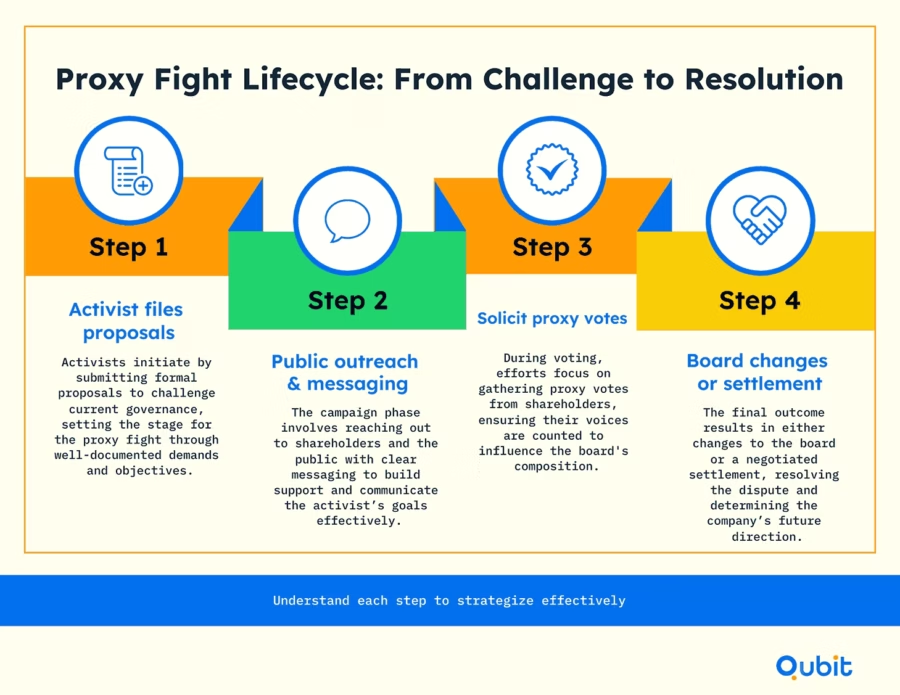Proxy fights, a critical aspect of corporate governance, often determine the future direction of a company. These battles arise when shareholders challenge the board’s decisions or seek to influence leadership changes. Success in such situations hinges on effective investor relations (IR), as building trust and communication with stakeholders can significantly impact the outcome. Companies aiming for an IR win must prioritize transparency and proactive engagement to secure shareholder support.
An overview of investor outreach strategies explains the foundational methods of cultivating investor relationships that support your navigation through complex proxy dynamics. This blog delves into the mechanics of proxy fights, explores trends in shareholder activism, and provides actionable strategies to help businesses thrive in these high-stakes scenarios. Let’s jump right in!
What You Need to Know About Proxy Fights and Their Effects
Proxy fights represent a high-stakes mechanism for reshaping corporate governance. These battles occur when activist shareholders seek to influence board composition, often aiming to steer a company toward strategic changes. A thorough understanding of a Proxy Fight is crucial to strategizing for potential board changes.
How Proxy Fights Unfold
Activist shareholders initiate proxy fights by rallying other investors to vote against the incumbent board or management. Their goal is often to replace specific board members with candidates who align with their vision for the company. This process typically involves extensive campaigning, including public statements and direct outreach to shareholders.
Recent high-profile losses, such as those at Disney and Norfolk Southern, highlight the risks inherent in these battles. Companies embroiled in proxy fights face not only reputational challenges but also potential disruptions to their strategic direction.
Financial and Strategic Implications
Proxy fights can significantly impact a company’s financial health. The costs associated with legal fees, public relations efforts, and shareholder communications can be substantial. Moreover, prolonged disputes may lead to market uncertainty, affecting stock prices and investor confidence.
On the strategic front, these battles often result in shifts in corporate priorities. For instance, activist shareholders may push for changes in operational focus, divestitures, or even mergers and acquisitions. While these changes can unlock value, they may also create friction within the organization.
Mitigating Risks Through Settlements
To avoid the prolonged turmoil of a proxy fight, many companies opt for preemptive settlements. This Settlement Trend demonstrates how more campaigns end in compromise rather than full proxy battles. By negotiating with activist shareholders early, companies can often reach agreements that balance shareholder demands with organizational stability.
Financial engineering is another tactic employed to mitigate risks. This involves restructuring assets or capital to address shareholder concerns without conceding control. Such measures can help companies maintain their strategic direction while appeasing activist investors.
The Growing Prevalence of Proxy Fights
The increasing frequency of proxy fights worldwide underscores their growing importance in corporate governance. A notable statistic is the 22% YoY Increase in proxy battles, reflecting heightened shareholder activism and evolving investor expectations.
Understanding the dynamics of proxy fights is essential for companies aiming to safeguard their strategic goals while addressing shareholder concerns. These battles, while challenging, can also serve as catalysts for positive change when managed effectively.
Activist investing has undergone a significant transformation, expanding its focus from traditional governance reforms to encompass environmental, social, and governance (ESG) priorities. This evolution reflects the growing demand for sustainable practices and performance-driven metrics in corporate strategies.
Institutional investors are playing an increasingly pivotal role in reshaping activist campaigns. Backed by sophisticated data analytics, these large-scale investors are driving targeted initiatives that aim to deliver measurable improvements. For instance, 60% of activist campaigns now benefit from institutional funding, underscoring the influence of these entities in modern investment for equity strategies.
Recent trends highlight the shift toward operational activism, or "Op Activism," where hedge funds and activist groups prioritize sustainable improvements over short-term gains. This approach aligns with the broader push for ESG integration, ensuring that companies not only meet financial goals but also address societal and environmental concerns.
Governance remains a central theme, with 40% of campaigns targeting board changes to enhance accountability and performance. The momentum is evident, with 137 new campaigns launched in the U.S., showcasing the growing appetite for activist-driven reforms. To contextualize these developments, Barclays provides valuable insights into recent U.S. activism trends and the frequency of campaigns. Reference Barclays for a deeper dive into these dynamics.
Avoiding communication pitfalls is equally critical when shaping new strategies. An analysis of common mistakes in investor communication outlines typical pitfalls, offering a clear perspective on potential issues that could affect credibility during board challenges.
As activist investing continues to evolve, staying ahead of these trends and strategies is essential for investors seeking to drive meaningful change while maximizing returns.
Smart Tactics for Winning Activist Campaigns and Proxy Fights
Activist campaigns and proxy fights often hinge on the strategic deployment of diverse tactics designed to influence board decisions and shareholder sentiment. From structured approaches like formal shareholder proposals to more aggressive strategies such as vote 'no' campaigns, activists employ a wide range of methods to achieve their objectives.
1. Formal Shareholder Proposals
One of the most common tactics involves submitting formal shareholder proposals. These proposals are typically aimed at addressing governance issues, operational inefficiencies, or strategic misalignments. By presenting clear, actionable requests, activists can rally shareholder support and compel boards to respond.
2. Vote 'No' Campaigns
Vote 'no' campaigns are a more confrontational approach, urging shareholders to reject specific board members or proposals during annual meetings. These campaigns often focus on highlighting perceived failures in leadership or strategy, creating pressure for change.
3. Proxy Battles
Proxy fights represent the most direct and high-stakes method of activism. In these scenarios, activists nominate their own slate of directors to replace existing board members, seeking to gain control or influence over the company’s direction. Success in proxy battles often depends on tactical precision, including personalized outreach to shareholders. A closer look at personalizing communication with investors reveals how tailored exchanges help you address individual concerns while reinforcing strategic engagements in proxy contexts.
Activists understand that the key to winning these battles lies in their ability to shift board dynamics decisively. Whether through structured proposals or aggressive campaigns, their tactics are designed to resonate with shareholders and drive meaningful change.
By mastering these approaches, companies can better anticipate activist strategies and prepare effective countermeasures, ensuring their boards remain aligned with long-term goals.
Spot the Warning Signs of an Activist Campaign
Activist campaigns often emerge when vulnerabilities within a company create opportunities for external pressure. Financial underperformance is one of the most significant risk factors. Declining revenues and falling share prices signal instability, making companies attractive targets for activist investors, including private investors seeking to capitalize on undervalued assets.

Weak corporate governance further amplifies exposure to activist campaigns. When boards fail to address shareholder concerns or exhibit transparency deficits, they inadvertently invite scrutiny. Neglecting shareholder feedback, especially through tools like a shareholder report, can alienate investors and fuel dissatisfaction.
Environmental, Social, and Governance (ESG) oversights are another critical vulnerability. With 78% of shareholders emphasizing ESG priorities, companies that fail to align with these expectations risk losing investor confidence. Reference this Investor Survey to understand the growing importance of ESG factors among shareholders.
Identifying these warning signs early allows companies to proactively address weaknesses and mitigate the risk of activist campaigns.
What You Can Do to Prevent Activist Challenges
Proactive measures can help companies stay ahead of activist challenges. Begin with consistent self-assessment to identify vulnerabilities in operations and governance. Regularly evaluate whether your business practices align with shareholder priorities, as this alignment can deter activist scrutiny.
A structured engagement plan is equally critical. Use tools like the Engage Guide to map out a systematic approach for maintaining open communication with key shareholders. This ensures that concerns are addressed before they escalate into activist campaigns.
Transparency plays a pivotal role in building trust. An exposition on the importance of transparency with investors highlights how open and honest dialogue contributes to building trust during shareholder engagements. This openness can serve as a deterrent to activist interest.
Responding to Activists: Strategies That Work
Effectively addressing activist proposals requires a structured and thoughtful approach. Begin by conducting an objective analysis of the activist’s demands to understand their potential impact on shareholder value. This evaluation should include a detailed review of financial data, operational metrics, and alignment with long-term company goals.
Once the analysis is complete, craft tailored responses that address the concerns raised while reinforcing the company’s strategic vision. Transparent communication is key to building trust among shareholders and ensuring alignment.
Finally, focus on consensus-building efforts. Engage shareholders through direct dialogue, presenting a balanced perspective that highlights the company’s strengths and future opportunities. A well-coordinated response not only mitigates activist pressures but also safeguards shareholder value, ensuring the company remains on track to achieve its objectives.
How Proxy Advisors Impact Votes and Credibility Risks
Proxy advisory firms play a crucial role in shaping shareholder voting outcomes, often influencing decisions on corporate governance matters. However, their recommendations can be compromised by conflicts of interest, such as ties to institutional investors or companies they evaluate. Additionally, frequent governance lapses and ownership changes within these firms may erode their impartiality, raising concerns about their credibility. To maintain trust amid such controversies, consistent communication strategies, like those outlined in how to manage investor expectations, are essential for fostering transparency and reliability.
Explore More Resources on Proxy Fights and Activist Tactics
Dive deeper into the world of shareholder activism with a curated selection of articles and tools designed to expand your knowledge of proxy battles and investor strategies. These resources provide valuable insights into the mechanics of proxy fights, offering actionable tactics and case studies to enhance your understanding.
Whether you're looking to refine your approach or explore the broader implications of activist campaigns, these materials serve as excellent follow-up reading for a comprehensive grasp of the subject. Stay informed and empowered as you explore the dynamics of shareholder influence and corporate governance strategies.
Conclusion
Effective strategies and proactive measures are essential for companies aiming to counter activist challenges successfully. Throughout this blog, we’ve explored key approaches, including fostering transparent communication with investors, understanding shareholder priorities, and implementing robust governance practices. These strategies not only help mitigate risks but also strengthen trust and alignment with stakeholders.
Proactive governance and clear investor communication are critical in maintaining stability and preventing proxy fights. By anticipating potential concerns and addressing them early, companies can safeguard their long-term vision while ensuring shareholder confidence.
If you're looking to gain strategic insights into your investor base and proactively mitigate proxy fight risks, we at Qubit Capital can help. Discover our Investor Discovery and Mapping service today.
Key Takeaways
• Proxy fights let activist shareholders push for change but carry major legal and reputational risks.
• Success depends on strategic board discussions and timely, preemptive settlements.
• Modern activists leverage ESG factors and data analytics to build stronger cases.
• Internal assessments and clear communication with shareholders are vital.
• Examples like Disney and Norfolk Southern show how high the stakes—and potential rewards—can be.
Frequently asked Questions
What is a shareholder proxy fight?
A shareholder proxy fight is a scenario where activist investors challenge the existing board by soliciting votes to install alternative management. It involves campaigning for proxy votes during shareholder meetings to effect change.


 Back
Back



